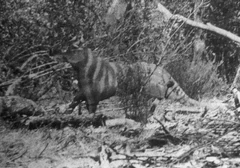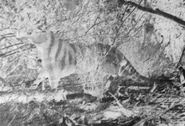| This article is currently under construction. |
| To prevent edit conflicts with the user who added this template, please refrain from making any major edits to this article. |
| This article was the second to be created on the Encyclopedia of Cryptozoology, on 19 January 2014 |
| ||||||||||||||
The Queensland tiger is a cryptid feline marsupial reported from Eastern Australia, usually identified with the Pleistocene marsupial lion (Thylacoleo carnifex) or a smaller relative, or more rarely with the thylacine or an entirely different form of marsupial or felid.[1][2] Although not as well-known as some other cryptids, it is one of the best documented, and in the middle of the 20th Century, when Bernard Heuvelmans wrote that it was the unknown animal closest to official recognition, it was often being described in natural history books on Australia.[3] Although not reported as often now as it was in the early 20th Century, sightings of the Queensland tiger continue to this day.
Description
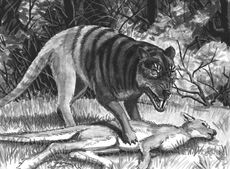
Illustration of a thylacine-like Queensland tiger with the classic thylacoleonid dentition, by William Rebsamen.
Accounts of the Queensland tiger are generally very consistent, and have been for a century. It is almost always compared to or described as a cat, more rarely a dog-like animal, and is usually described as between 4' and 5' including the tail, which is said to be long and thick, and is sometimes reported to have a tuft on the tip.[4] Its average height at the shoulder is said to be about 1' 6'', and it is built much heaver than a domestic cat.[2] Its legs are described as relatively short, its paws as large, and its claws as long. The head is round and cat-like, and particularly large and powerful in proportion to its body. It is very often described as having "tusks" or fangs, in one account compared to sabre-teeth. Its eyes are said to be green, and its ears are pointed like those of a cat.[2]
A number of "colour morphs" are reported of the Queensland tiger. Its coat is said to be short and inclined to be coarse, and it is usually described as having black stripes encircling its body, compared to hoops by Karl Shuker.[5] Beneath the striped, its fur is usually said to be fawn, tan, or grey, but dark brown and all-black animals have also been reported.
It tends to be reported from near mountainous, "rough, rocky country on top of the ranges,"[3] and close to thick rainforests,[5] chiefly in places inhabited by tree kangaroos and rock wallabies.[3] It is principally reported from Queensland, especially from the coastal ranges: "in northern Queensland, from Cairns to Cardwell; in southeastern Queensland, from Biggenden to Tamborine Mountain".[2]
Physical evidence
Photographs and videos
Tracks
Attestations
Naturalist and explorer of Australia Carl Lumholtz included a description of the yarri, gleaned from Aboriginal accounts, in his book Among Savages (1889).
| “ | During my association with these savages I learned that on the summit of the Coast Mountains, before mentioned, there lived two varieties of mammals which seemed to me to be unknown to science; but I had much difficulty in acquiring this knowledge. One of the animals they called yarri. From their description I conceived it to be a marsupial tiger. It was said to be about the size of a dingo, though its legs were shorter and its tail long, and it was described by the blacks as being very savage. If pursued it climbed up the trees, where the natives did not dare follow it, and by gestures they explained to me how at such times it would growl and bite their hands. Rocky retreats were its most favourite habitat, and its principal food was said to be a little brown variety of wallaby common in Northern Queensland scrubs. Its flesh was not particularly appreciated by the blacks, and if they accidentally killed a yarri they gave it to their old women. In Western Queensland I heard much about an animal which seemed to me to be identical with the yarri here described, and a specimen was once nearly shot by an officer of the black police in the regions I was now visiting.
|
” |
Sightings
Overview
Far over two hundred accounts of Queensland tiger sightings have allegedly been recorded since the early 19th Century, but farmers found them pests and killed many of them. For 150 years, European explorers, settlers, farmers, and bush walkers allegedly observed, shot, skinned, and examined these animals.[2] The significance of most of the animals that were shot was never realised - as such, carcasses were discarded, and in one case a body was left ouside and devoured by wild pigs.[6]
Undated
Naturalist George Sharp claimed to have briefly spied a large striped animal whilst hunting for eggs of the golden bower-bird (Ptilonorhynchus) near the source of the Tully River:
| “ | ” |
A little while after the Sharp sighting, a tiger was allegedly killed on the Atherton Tableland whilst attacking a farmer's goats. Sharp heard of the incident and was able to examine the skin, which he described as being about five feet long from the nose to the tip of the tail. However, Sharp had no means of preserving the skin, and it was allowed to decay; wild pigs had already eaten the head and body.[4][3]
A Mr. Endres of Mundubbera in Queensland allegdly captured a live Queensland tiger, which Karl Shuker suggests may have been a young individual on account of its size. The fate of the animal is unstated, and Endres described it as:[4][3]
| “ | ...about 18 inches high and as long as a large cat; very short head and neck; striped, but not right round; very savage when caught.
|
” |
Ion Idriess, an Australian author who spent much of his life in rural regions, reported two encounters with the Queensland tiger, both occuring near the Alice River. Bernard Heuvelmans noted that Idreiess wrote about the Queensland tiger as if it were a rather commonplace animal.
| “ | Up here in York Peninsula we have a tiger-cat that stands as high as a hefty, medium-sized dog. His body is lithe and sleek and beautifully striped in black and grey. His pads are armed with lance-like claws of great tearing strength. His ears are sharp and pricked, and his head is shaped like that of a tiger. My introduction to this beauty was one day when I heard a series of snarls from the long buffalo-grass skirting a swamp. On peering through the grass I saw a full-grown kangaroo, acked up against a tree, the flesh of one leg torn clean from the bone. A streak of black and grey shot towards the 'roo's' throat, then seemed to twist in the air, and the kangaroo slid to earth with the entrails literally torn out. In my surprise I incautiously rustled the grass, and the great cat ceased the warm feast that he had promptly started upon, stood perfectly still over his victim, and for ten seconds returned me gaze for gaze. Then the skin wrinkled back from the nostrils, white fangs gleamed, and a low growl issued from his throat. I went backwards and lost no time in getting out of the entangling grass.
The next brute I saw was dead, and beside him was my much-prized staghound, also dead. This dog had been trained from puppy-hood in tackling wild boars, and his strength and courage were known by all the prospectors over the country. The cat had come fossicking round my camp on the Alice River.[4][3] |
” |
Idriess' account is identical, word for word, to a story given in D. H. Lawrence's novel Kangaroo (1923), leading Michel Raynal to label Idriess' two sightings as hoaxes.[7] However, as discovered by Malcolm Smith, it was in fact Lawrence who took the story from Idriess, who first published it under the pseudonym "Gouger" in the periodical Bulletin (8 June 1922). Lawrence read the report whilst in Australia, and decided to incorporate it into his book: the character who tells the story in Kangaroo actually states that it came from the Bulletin.[8]
1864
A bullock-driver near Cardwell claimed to have seen a tiger in 1864, but as he was a notorious liar, he was not believed.[9]
1871
The thirteen year old son of Cardwell police magistrate Brinsley G. Sheridan chased a striped 'cat' up a tree in or shortly before 1871. It became aggressive when the boy's dog growled, and it chased them home.[3] Zoologist Philip Sclater passed on Sheridan's account of his sons encounter to the Zoological Society of London, of which he was Secretary, in 1871:
| “ | One evening strolling along a path close to the shore of Rockingham Bay, a small terrier, my son's companion, took a scent up from a piece of scrub near the beach, and followed, barking furiously, towards the coast-range westwards. My boy (thirteen years of age, but an old bushman, who would put half those described in novels to the blush) followed and found in the long grass, about half a mile from the spot the scent was first taken up, an animal described by himself as follows : — ' It was lying camped in the long grass and was as big as a native Dog ; its face was round like that of a Cat, it had a long tail, and its body was striped from the ribs under the belly with yellow and black. My Dog flew at it, but it could throw him. When they were together I fired my pistol at its head; the blood came. The animal then ran up a leaning tree, and the Dog barked at it. It then got savage and rushed down the tree at the Dog and then at me. I got frightened and came home.
It was just dark when the boy came home in a high state of excitement and told me the story. From inquiry I find that this is not the first time a similar animal has been seen in this neighbourhood. Tracks of a sort of Tiger have been seen in Dalrymple's Gap by people camping there, and Mr. Reginald Uhr, now Police Ma- gistrate at St. George, whilst one of the native mounted police officers in this district, saw the same animal my son describes. The country is so sparsely populated, and the jungles (or, as we call them here, 'scrubs') so dense and so little known, that I have no doubt that animals of this kind exist in considerable numbers, the abun- dance of food and their timidity preventing our more intimate know- ledge of their habits. I shall be most happy to send you, should it be my good fortune to drop across one of them, its skin and skeleton. I only regretted, as my poor boy did, that he had not my revolver, as he says he stood, when it was fighting with the Dog, at less than a yard from the animal.[10] |
” |
Later in the year, in early December, a surveyor named Hull was working with a party of five men near the Murray and Mackay Rivers, north of Cardwell. Between 8 and 9 o'clock one night, all the men were startled by a loud roar close to the tents. They armed themselves and searched the area, but the animal had already departed; in the morning, however, they found and sketched its tracks. The men with Hull told the same story when interviewed, and additionally claimed to have heard the roars for three nights in a row.[9] Zoologist Gerard Krefft believed the track was that of an ordinary dog.[3]
1872
Police officer Robert Arthur Johnstone claimed to have come across a large animal in a tree, about 12 metres from the ground, west of Cardwell in 1872, alongside a group of native police. When they approached it, the animal jumped 3 metres across to another tree, then "slithered" down tail first.[3] Johnstone later discovered its den, littered with the crushed bones of rock wallabies.[2] He described the animal as larger than a pointer, with "fawn-colored with darker markings and [...] a long, thick tail and a round head with no visible ears".[11]
1896
Rex Gilroy reports that, in 1896, a farmer living in Atherton repeatedly lost calves, sheep, and goats to a mystery predators which raided his farm, leaving only large paw prints in the mud. One day, from the kitchen window, he saw the predator, which he described as a little larger than a German shepherd, with greyish fur and darker stripes. The animal dashed across the paddock about 50' away from the window, pounced on a calf, and grabbed it by the throat. By the time French had rushed outside with his rifle, the animal had disappeared, but he managed to track it down, dragging its kill through the scrub, alongside his two teenage sons. They eventually discovered it in a clearing, perched in a gum tree some 20' off the ground, the calf's body wedged between the trunk and the branch. French shot the animal dead, and later skinned it.[12]
1900
J. McGeehan claimed to have come across a "striped marsupial cat" being attacked by dogs and "crying piteously" near Kairi in 1900. The cat was clearly striped in alternate dark brown and white rings about 7 centimetres wide, had a head like a Pomeranian dog, and was about 60 centimetres long in all.[2] Bernard Heuvelmans believed this was a young individual.[3]
1920
In 1920, two men on horseback, G. de Tournoeur and P. B. Scougall, claimed to the Brisbane Courier that they had encountered a Queensland tiger at Munna Creek. They described:
| “ | We dismounted and were startled to find the cause to be a large animal of the cat tribe, standing about twenty yards away, astride of a very dead calf, glaring defiance at us, and emitting what I can ony describe as a growling whine. As far as the gathering darkness and torrential rain allowed us to judge he was nearly the size of a mastiff, of a dirty fawn colour, with a whitish belly, and broad blackish tiger stripes. The head was round, with rather prominent lynx-like ears, but unlike that feline there were a tail reaching to the ground and large pads. We threw a couple of stones at him, which only made him crouch low, with ears laid flat, and emit a raspy snarl, vividly reminiscent of the African leopard’s nocturnal 'wood-sawing' cry. Beating an angry tattoo on the grass with his tail, he looked so ugly and ready for a spring that we felt a bit 'windy '; but on our making a rush and cracking our stockwhips he bounded away to the bend of the creek, where he turned back and growled at us.[3][4]
|
” |
1926
Another tiger was killed by dogs in 1926, the same year that a "cat" the size of a sheepdog was killed.[2]
1932
A tiger was shot in 1932.[2]
1940
In May or June 1940, Nigel and Charlie Tutt were hiking on Mount Stanley when they rounded a bend and saw a large cat sunning itself on a pine stump. They stopped about 20 feet away from it and noted that it was reddish, with dark-brown stripes all over its body and legs. It looked at them coolly for about twenty seconds and then bounded away.[2]
1954
A man named Gamer was riding through the brush near Bidwell, Queensland, in 1954 when he surprised a large, gray cat with dark-orange stripes. He was struck by its savage nature and large fangs.[2]
1967
In late 1967, an aggressive animal the size of a dog was shot by Carl Lentz. He intended to keep the carcass, but heavy flooding in the night caused him to skin it and leave the body.[13]
1968
A Queensland Tiger spotted on Mount Bartle Frere in 1968 was described as having a round, broad head, a nose shorter and broader than a dog's and some of its teeth appeared to protrude out and upwards like tusks.[14]
1969
Scientist Gary Opit allegedly saw a giant quoll-like animal along Brisbane's Gold Coast Highway in 1969. He was alone, and got a clear view of the animal, which walked like a marsupial. He has seen the animal on multiple occasions since, and his encounters with the beast have stretched as far north as Mt Tamborine.[15] His brother John Opit has also seen the Queensland tiger. Opit described his encounter:[16]
| “ | At about 11 pm, as I travelled south through long stretches of darkened forest with very little other traffic, I observed a large carnivorous mammal suddenly cross the road directly in front of my vehicle.
It emerged about 30 metres in front of the car on my side of the road (the left hand or eastern side) and I saw its head, shaped something like a mastiff dog, protrude from the vegetation and watched it walk across the grassy road verge and onto the bitumen. I applied the brake not wanting to hit what at first I thought must be a dog. Then I accelerated up to it when I realised that it was not a dog. It stood approximately 60 cm at the shoulders, had a body length of about 75-cm and a tail of the same length. The snout protruded from a round head with small pricked ears. It had a powerfully built body covered in brindled somewhat thick fur with indistinct stripes appearing beneath the thinner black outer coat The fore and hind legs were about the same size, the rump and hind legs appeared reasonably powerful and what was distinctly noticeable was a marsupial-like waddling gait that particularly caught my attention. It reminded me of the gait of a brush-tailed possum only this animal was very much larger. Its robust form, muscled legs and large feet indicated to me that it was adapted to terrestrial locomotion with a strong tree climbing ability. It had a long straight thickly furred tail with 6 bands or stripes across it and the tail did not wag from side to side as it walked across the road. When my car closely approached the strange animal it raised all the hairs on the tail, as a dog may raise its hackles when disturbed, as if it was attempting to make itself look larger. This very distinctive banded tail was the last I saw of the animal as it disappeared into thick vegetation on the western side of the road. At no time did it look at my closely approaching vehicle or increase its speed as it crossed the road. |
” |
At the time Opit considered the possibility that it was some species of escaped civet, but he also connected it with the "marsupial cat" described by Ellis Troughton.
circa 1970's
From 1970 to 1973, naturalist Janeice Plunkett collected more than 100 reports of the tiger throughout Queensland.[2]
1982
In 1982 a leopard-sized creature with a cat-like gait and heavily striped tail was reported near Perth.[14]
1983
Mike Jones ran across a black-striped, panther-sized animal feeding on a dead calf in the mountains near Mareeba, Queensland, in 1983.[2]
1984
In 1984, a panther-sized striped cat-like animal was seen sitting in a tree devouring a sheep, and was also heard roaring near a creek at Daintree.[14]
circa 1985
Gary Opit collected an account of a marsupial lion encounter which supposedly occured in the Billinudgel Nature Reserve sometime around 1985. Opit's contact:
| “ | ...was driving along the coastal sandy 4 wheel drive track (now closed to all but walkers, cyclists & national park vehicles) that runs just behind the beach at 2 am returning home from a late night out when a black panther-like animal crossed the track right in front of his car. He described it as being very heavily built, like a bear crossed with a panther & was positive from its appearance that it could only be a marsupial lion which he had read about in a book on Aussie prehistoric fauna, but which he didn't have too much interest in. It scared him with its powerful unconcerned attitude. It had a thickly furred curved tail. He drove on and seconds later an emu, perhaps being hunted by the animal, run up from behind past the car, unusual for a diurnal bird, which further shocked him as he thought it was the big cat-like beast attacking his car.[16]
|
” |
1987
On May 30, 1987, Greg Calvert found tracks larger than a dingo’s near Hughenden, Queensland, and followed them for several hundred yards. They showed the grooming claws of a marsupial.[2]
Also in 1987, a hunter near Hughenden was pursuing a dingo he had wounded when a large hay-coloured animal with black body stripes suddenly appeared and attacked and ate the dingo.
1990
Gilroy writes that a pair of fishermen camped overnight on the Wenlock River, Cape York Peninsula, in November 1990, Jim Spriggs and Tony Banks, were awoken at dawn by the clatter of cooking utensils, allowing them to see a greyish animal with black stripes rummaging through the camp's belongings.
| “ | Before the creature ran off into the trees, we both noticed it was a female with a reversed pouch, which was carrying a pup, said Jim to me later. Tony was walking down the track from their four-wheel drive vehicle later that morning when he found a number of strange, large paw impressions in the dirt, which he took to be those of the mystery animal. The creature we saw was rather thickset, and would have been about 5ft length from nose to tail tip. I think she stood about 1 ½ ft on all fours, and I think the tail looked a little bushy.[12]
|
” |
1991
According to Gilroy, a biker named Don Moss encountered "a large, fawn-coloured animal with black body stripes" sitting in a tree whilst exploring a scrubland track west of Townsville. Upon seeing him, the surprised animal leapt from the tree and bounded into the scrub. When he arrived at the tree, Moss discovered a dead goat about 15' from the ground, wedged between trunk and limb.[12]
1995
In 1995, Goldsborough Valley resident "Wharfie" Mark Camplon was sitting on his verandah when his dog Rusty began to grow afraid of something unseen. He soon heard a deep growling. Camplon said people who thought he had been hitting the booze should go an spend some time in the valley:
| “ | ...once you are here, away from civilisation and all the noise and lights, it's easy to believe that a creature could live for years away from the eyes of man. You could lose an army up here, let alone a family of cats or something similar. Especially if they were well adapted to the area.[17]
|
” |
In mid-September 1995, a dead female Queensland Tiger was allegedly found beside the Bruce Highway about 12.5 miles south of Cardwell. It was described it as the size of a small cattle dog, with a cat-like face, short pointed ears, large hindquarters and stripes near the chest from backbone down to belly. The distinctive stripes were regularly spaced on a dark tan background colour. The tail had a tiny white tip. Some of the dark brown hairs below the chest had black tips, formed four black stripes. The remains were too mangled and decomposed for conclusive identification, and no testing was ever done, apparently.[14]
circa 2000
Around 2000, Dennis Wright was out shooting in Australia when he saw what appeared to be a big black cat. He looked at it through binoculars, and realised it had a wombat-like head. Opting not to shoot, he went over to it, but it was gone when he arrived at the tree it was standing under. Later, he realised that the animal had climbed the tree, and was there when he was searching below the tree, but refrained from attacking.[18]
2002
On 21 June 2002, a wombat-like feline animal was reportedly seen near a disused logging coop in Gilderoy by a family driving past:
| “ | Driving slowly with the Rangie's lights and spots on, one child commented that something was coming down the hill towards the road as he could see the undergrowth moving around. Thinking it might be a kangaroo or wombat I slowed down. The thing came off the hillside and got onto the road. My first thought was it looked like a quoll on steroids it was so big. It was uniformly dark in colour, about 80cms at the shoulder and about 1.5m from nose to tail. The head had the same sort of stub nose like a Tasmanian Devil (with the same sort of heavy jaws), and a long tail like a kangaroo which it seemed to use for balance or steering - (it didnt move about like a cats, it looked fairly rigid and slightly curved). The thing looked large and powerfully built, but it had a quite graceful (almost arrogant) stride to it. I stopped; it walked into the middle of the road (and our lights); turned and looked at us for perhaps 30 seconds and sauntered across to the other side where it went down into the gully. I drove to the spot, got out and took a mobile spot to the edge of the gully. The animal followed the creek for about 10-20m, crossed it and disappeared into the bush on the other side. My family and I looked for tracks but the road was pretty much covered with gravel and small rocks and so not much could be seen. However the smell in the air where the thing had been was pretty unspeakable - rotting flesh.[19][16]
|
” |
2005
A farmer, searching for a missing cow in 2005, found that it had been severely wounded by a broad-headed predator, present at the scene, that "seemed to have some marsupial-like attributes" being long-bodied, short-legged and long and thick in the tail. The creature had also killed the cow’s calf.[20]
2007
- Main article: Singleton giant quoll.
The Singleton giant quoll is almost universally speculated to be a Queensland tiger: the only different is that the quoll had a longer muzzle. A $1000 reward has been offered by "Mike" for anyone who takes a photograph of the animal.[21]
2008
In the December of 2008, a woman named Jennifer was driving through Castlereagh Hwy, near Pearson's Lookout between the towns of Capertee and Ilford, in a large truck. Whilst driving, she allegedly passed two dead animals together - a kangaroo, and another, unidentified animal akin to a lion cub. She described it as follows:
| “ | The markings on the torso of the other animal were dark brown / black and the main colour was tan. The markings made me look closer and the carcass was intact. The ears were rounded, the head was stout and like a lion cub and the front paws were huge in comparison to it's body size. The back paws and tail were obscured because of the position it landed in after being run over. (probably feeding on the small roo). My first thoughts were of a small lion, but the dark marking's threw me. It was a thick set animal about 500 - 600mm long. For the rest of the trip to Sydney (2.75 hrs) I couldn't stop wondering what this thing was, and having told the story to several people, I still couldn't come up with a logical explanation.[16][22]
|
” |
2009
An eyewitness from Warburton, Victoria reported that on 28 August 2009, they:
| “ | ...went for a walk up the tip road which runs straight up the hill and then winds it's way around to Warburton, I left the road at the end of the straight and headed up a track that used to be used by dirt bikes, the track had been dig up by an excavator to prevent them from using it. The hill is very steep so I was watching my footing (and for snakes) and in my own little world when I heard what I can only explain as a gasping hiss. adrenalin shot down my spine as my head shot up with enough time to see a rather large hind quarters of a cat like animal shoot into dense brush about 10-15 metres away. It took me a moment to registers what I saw. All sightings I had heard over the years had been of a puma type cat with a slender tail, this was smaller, about kelpie [a breed of Australian sheepdog] size but very powerful hind quarters, very muscly, not a nice rounded rump like a Wallaby.
It's tail was about a mans arms length long and thick and sort of bristly, unfortunately I didn't see it's head. I was waiting to hear the sound of it bounding through the scrub but there was no bounding, just the sound of it crashing through the brush. I think we startled each other. I stayed up there for about an hour but saw no heard anything else until on my way I found prints in the upturned excavation work, they were very clear to the eye but the camera did a shit-house job of bringing up the definition.[16] |
” |
2010
In 2010, a Queensland tiger allegedly ran across the road in front of a car, at extreme speed.[23]
2012
In February of 2012, a woman was driving down a road in Nimbin at night when a large animal walked out in front of the car. It looked like a lion, but had a striped flank.[24]
Theories
Mistaken identity
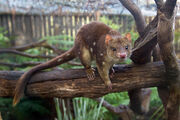
The tiger quoll (Dasyurus maculatus) is also called the yarri, but it does not closely resemble descriptions of the Queensland tiger.
One sceptical identity which has been suggested for some Queensland tiger sightings is that the animals are misidentified tiger quolls (Dasyurus maculatus), which can grow up to 2' long with a 1' 6'' tail - in addition, it is in fact sometimes referred to as the "tiger-cat" or even yarri. However, the tiger quoll is very clearly spotted, not striped, and more closely resembles a weasel than a cat, with a pointed face, leading most cryptozoologists to discount it as a good identity candidate for the majority of sightings.[2][25]
Suggestions of misidentified dingos, feral dogs, oversized domestic cats, and escapee tigers are also discounted by Karl Shuker on account of the highly distinctive features of the Queensland tiger. It is described as having hooped stripes around its body, tusk-like teeth protruding from its mouth, and arboreal habits - features which no single one of these animals would have all at once - and the longstanding Aboriginal knowledge of the animal as the yarri shows that it was present before Europeans arrived in Australia. All this leads Shuker to write that "it is clear [...] that attempts to identify the yarri as anything so conservative as an oversized domestic cat, misidentified dog or dingo, or the occasional escapee tiger are woefully ill-founded".[5]
Marsupial lion
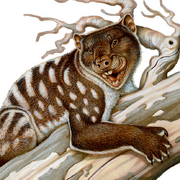
The marsupial lion (Thylacoleo carnifex), as drawn by H. Kyoht Luterman, is the most popular Queensland tiger identity.
The Queensland tiger appears to be a marsupial. A number of sightings describe it with marsupial characteristics such as a stiff kangaroo-like tail, a wombat-like head, and rarely even a pouch. The apparently traditional Aboriginal knowledge of the yarri also strongly supports the theory that it is a marsupial, as all native Australian terrestrial mammals other than rodents are marsupials or monotremes.
Descriptions of the Queensland tiger are extraordinarily consistent with the conjectured appearance and habits of the marsupial lion (Thylacoleo carnifex), which is known to have lived in Australia until at least around 40,000 years ago, although according to Shuker, fossils 16,000 years old are common, and remains as young as 6,500 years old may exist.[2] Thylacoleo is most closely related to phalangers, koalas, and wombats, not to the dasyurids, the family which contains all the rest of Australia's predatory mammals.[5]
Based upon its fossils, Thylacoleo was a vaguely cat-shaped animal, with a round and stocky head, powerful jaws, long legs, and long claws. It also had pseudo-opposable thumbs on both front paws, strongly suggesting an arboreal lifestyle;[5] indeed, it is now believed to have ambushed its prey by jumping down from trees. In addition, a number of cave paintings discovered in Australia which may depict Thylacoleo show the animal with a striped coat[5] (although the stripes are not "hoops," like on the Queensland tiger; they are restricted to the top of the animal's back); and some eyewitnesses have noted a forward-facing tuft on the animals tail. In 2008, an Aboriginal cave painting was found depicting what appears to be a Thylacoleo with a tufted tail.
The teeth of Thylacoleo, however, may be the most consistent detail. Thylacoleo possessed a pair of fangs, not elongated canines, but elongated incisors, right at the front of its mouth. These fangs would have resembled tusks or even the beak of a parrot, and would be highly visible to eyewitnesses given their place at the very front of the mouth.[5]
Indeed, Shuker notes that "Thylacoleo's likely appearance in life is an extraordinarily close match with eyewitness descriptions of the yarri. Indeed, the reconstruction is so similar to these descriptions that it could be easily mistaken for one of them itself."[5][note 1] Consequently, a number of Queensland tiger researchers regard the cryptid as a marsupial lion, and even refer to it as Thylacoleo.
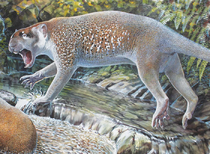
A smaller relative of Thylacoleo, similar to the much earlier Wakaleo, drawn by Peter Schouten, may be a more likely Queensland tiger identity than Thylacoleo itself.
Thylacine
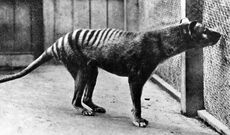
The thylacine has sometimes been put forwards as a Queensland tiger identity, but it does not really resemble the cryptid.
Some cryptozoologists have connected Queensland tiger sightings with possible mainland thylacines.[2] The primary reason for favouring this theory over the marsupial lion theory is that the thylacine is believed to have disappeared from the Australian mainland far later than Thylacoleo, making its continued existence in some form more likely.
However, as noted by researchers including Shuker and Michel Raynal, the appearance and habits of the thylacine are entirely inconsistent with those of the Queensland tiger. The thylacine was, or is, a dog- or wolf-shaped animal with a long, thin muzzle, did not have arboreal habits, and is not believed to have been particularly vicious. The Queensland tiger, on the other hand, is always described as having a short, cat-like face, is arboreal, and is reputed to be aggressive and dangerous.[7] George Eberhart also notes that the tusklike teeth, curved claws, and leopard-like growl are not features of thylacines, and that the stripes of the Queensland tiger, whilst similar to those of a thylacine, are different in that they are said to wrap around its stomach and sides, and terminate before reaching its spine. The stripes of the thylacine are only on its back and sides.[2] Shuker writes that the identification of the Queensland tiger with a thylacine is more "an act of despair than diligence".[5]
Similar cryptids
- Alien big cats in Australia.
- The Singleton giant quoll.
- The warrigal, a large maned cat with protruding teeth, reported from Australia's Blue Mountains.
Further cryptozoological reading
- Bernard, Heuvelmans (1955) On the Track of Unknown Animals
- Healy, Tony (1994) Out of the Shadows: Mystery Animals of Australia
- Opit, Gary (2009) Australian Cryptozoology
- Williams, Mike and Lang, Rebecca (2010) Australian Big Cats: An Unnatural History of Panthers
- O'Reilly, David (2011) Savage Shadow: The Search for the Australian Cougar
- Wright, Dennis (2017) Thylacoleo Lives
Notes and references
- ↑ The image by Neave Parker which heads this article was drawn as a depiction of the Queensland tiger, but is described by some websites as a reconstruction of Thylacoleo itself.
- ↑ Shuker, Karl P. N. "A Supplement to Dr Bernard Heuvelmans' Checklist of Cryptozoological Animals," Fortean Studies, Vol. 5 (1998)
- ↑ 2.00 2.01 2.02 2.03 2.04 2.05 2.06 2.07 2.08 2.09 2.10 2.11 2.12 2.13 2.14 2.15 2.16 2.17 Eberhart, George M. (2002) Mysterious Creatures: A Guide to Cryptozoology, ABC-CLIO, Inc., ISBN 1576072835
- ↑ 3.00 3.01 3.02 3.03 3.04 3.05 3.06 3.07 3.08 3.09 3.10 3.11 Heuvelmans, Bernard (1955) On the Track of Unknown Animals, Routledge, ISBN 978-1138977525
- ↑ 4.0 4.1 4.2 4.3 4.4 4.5 Souef, A. S (1926) The Wild Animals Of Australasia
- ↑ 5.0 5.1 5.2 5.3 5.4 5.5 5.6 5.7 5.8 Shuker, Karl P. N. (1995) In Search of Prehistoric Survivors: Do Giant 'Extinct' Creatures Still Exist?, Blandford, ISBN 9780713-724691
- ↑ Shuker, Karl P. N. ShukerNature: FROM BLACK LIONS TO LIVING SABRE-TOOTHS - MY TOP TEN MYSTERY CATS karlshuker.blogspot.com [Accessed 2014]
- ↑ 7.0 7.1 Raynal, Michel "Le "chat-tigre" du Queensland" Institut Virtuel de Cryptozoologie cryptozoo.pagesperso-orange.fr [Accessed 11 June 2019]
- ↑ Shuker, Karl P. N. (2016) Still In Search Of Prehistoric Survivors: The Creatures That Time Forgot?, Coachwhip Publications, ISBN 978-1616463908
- ↑ 9.0 9.1 Walter J. Scott, "Letter from W. J. Scott, Addressed to the Secretary, Respecting the Supposed ‘Native Tiger’ of Queensland", Proceedings of the Zoological Society of London 1872
- ↑ "Notice of the Existence in Queensland of an Undescribed Species of Mammal", Proceedings of the Zoological Society of London 1871
- ↑ Johnstone, Robert Arthur (1905 Spinifex and Wattle: Reminiscences of Pioneering in North Queensland
- ↑ 12.0 12.1 12.2 Gilroy, Rex Rex & Heather Gilroy Research of the Australian Panther - Queensland Research mysteriousaustralia.com [Accessed 12 June 2019]
- ↑ Centre for Fortean Zoology Australia: NSW 'Thylacine' sightings update cfzaustralia.com [Accessed 2014]
- ↑ 14.0 14.1 14.2 14.3 Cite error: Invalid
<ref>tag; no text was provided for refs namedParanormal - ↑ Thylacoleo Alive and Well up North? cfzaustralia.com [Accessed 2014]
- ↑ 16.0 16.1 16.2 16.3 16.4 Big Cat Witnesses
- ↑ The Marsupial Lion
- ↑ Wright, Dennis (2017) Thylacoleo Lives
- ↑ Yowie Hunters
- ↑ The Cryptozoologist
- ↑ Cite error: Invalid
<ref>tag; no text was provided for refs namedSingleton - ↑ Centre for Fortean Zoology - Thylacoleo Roadkill in NSW?
- ↑ Mystery Beast Sighted in Hunter Valley, NSW
- ↑ Nimbin sighting of possible thylacine or marsupial lion
- ↑ Cite error: Invalid
<ref>tag; no text was provided for refs namedShuker19952

